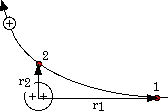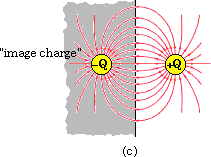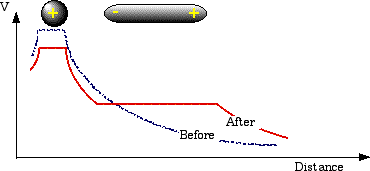
Answer [1]: The potential at an "open" corner is simply the (algebraic) sum of the potentials at that point due to the individual charges. Since the potential of a point charge is given by kQ/r, and the charges are opposite in sign, the potential due to the two charges
where r1 and r2 are the distances from charges Q1 and Q2 to a vacant corner, respectively. For the potentials on both vacant corners to be the same the distances have to be the same,
So, the two charges must be placed on diagonally opposite corners.
Answer [2]: Actually, it doesn't matter how you arrange the charges, the potential at the vacant corner is always positive!

Assume that the charges have magnitude Q. Since we have to take the sum of the individual potentials we have:
See, they're all positive!
Answer [3]: The electric field is the vector sum of the individual electric fields at the center; the potential is the algebraic sum of the individual potentials at the center.

So, if two diagonal charges have the same magnitude and sign then the electric fields due to these charges have equal magnitude but opposite directions and their resultant is zero. Therefore, the total electric field at the center will be zero if each diagonal pair of charges has the same magnitude and sign.
If a diagonal pair of charges has the same magnitude and sign they produce a non-zero potential. So, for a zero total potential, the potential of one diagonal pair must cancel the potential of the other diagonal pair. This will occur if the two pairs have opposite signs.
So, the electric field and the potential will both be zero if Q1 and Q3 have the same sign and Q2 and Q4 have the same sign, which is opposite to the signs of Q1 and Q3.
Answer [4]: No, the fact that E = 0 does not mean that V = 0. By definition, E = -dV/dx, therefore, if E = 0, V is constant, but not necessarily zero. Let's look at an example

At the midpoint beween two identical charges, P, the resultant electric field is zero. However, the algebraic sum of the potentials is 2kQ/r. i.e., non-zero.
Answer [5]: The electron is traveling considerably faster than the proton. Why? ... well, in both cases the work done is the same. The work-energy theorem tells us that the change in kinetic energy is equal to the work done and so the change in kinetic energy is the same. Since, in each case, the initial kinetic energy of the "moving" particle is zero, their final kinetic energies, when the collisions occur, are the same. However, a proton has a mass that is ~1800 times that of an electron and so the electron is traveling about 42 times faster than the proton.
Answer [6]: The charge has to be moved along a line of constant potential, i.e., an equipotential surface. An equipotential surface is perpendicular to the electric field; so the charge should be moved along a line that is perpendicular to the field lines. Note also, since the charge is moved along an equipotential surface, no work is done.
Answer [7]: If the two, fixed charges are both positive then a positive test charge experiences a repulsive force from each of the charges. Halfway between the charges, the resultant of the two repulsive forces will be zero. As the test charge is moved from the midpoint, it will feel a net force that tends to push it towards the midpoint. Therefore, the midpoint between two positive charges is a position of lower potential energy; thus, it is analogous to the bottom of a valley.
If the two, fixed charges are both negative then a positive test charge experiences an attractive force from each of the charges. Halfway between the charges, the resultant of the two attractive forces will be zero. However, as the test charge is moved from the midpoint, it will feel a net attractuve force that tends to pull it away the midpoint. Therefore, the midpoint between two negative charges is a position of higher potential energy; thus, it is analogous to the top of a hill.
A similar analysis suggests that if the test charge is negative, the midpoint beteen two positive charges is analogous to the top of a hill. On the other hand, if the test charge is negative, the midpoint beteen two negative charges is analogous to the bottom of a valley.
Answer [8]: Each particle experiences a force |F| = |eE|, which is the same in both cases and constant, since the electric field E between to parallel plates is constant. Although the magnitudes of the forces are the same, the electron moves upward and the proton moves downward. The distance traveled by the electron and the proton are the same and so the work done by the field on each particle is the same. The work-energy theorem tells us that the change in kinetic energy (of each) particle is the same as the work done, i.e., identical in both cases. The electron and proton both start from rest, but because the mass of the proton is ~1800 times that of the electron, the velocity of the electron is greater. Therefore, the electron strikes a plate first.
Also, from Newton's 2nd Law, if the force each particle experiences is the same, the acceleration is inversely proportional to the mass. Since the electron's mass is about 1/1800 the mass of the proton, the electron will experience an acceleration some 1800× greater than the proton. Since the particles travel the same distance, the electron will strike the +ve plate before the proton strikes the -ve plate.
Answer [9]: Charges, like a ball on a hill, will always move from a position of high potential erergy to lower potential energy.
Answer [10]: The potential at the point P due to an increment of charge (dQ) is k(dQ)/r. The total potential is the sum of the contributions of all the increments around the ring. Since potential is a scalar, and the point P is equidistance from all points on the ring, the potential is completely independent of how the charge is distributed around the ring; it only depends on the total charge.
The electric field, on the other hand, because it is a vector, does depend on how the charge is distributed. If the charge is uniformly distributed the Ey components from each increment on opposite sides of the ring cancel so the field is directed along the x-direction only. If the charge is not uniformly distributed, this cancellation will not occur so there will be Ey components.
Answer [11]: When two finite, charged objects are brought into contact, charges will flow from one to the other until their potentials are the same. So, the initial potential of A is
and the initial potential of B is
Since RA > RB, VA < VB. Consequently, when the spheres are connected by a wire, charge will flow from B to A until the potentials are equal, i.e., until VA = VB. Then
i.e., QA/QB = RA/RB.
Since charge is conserved
If we are are dealing with point charges then their radii are the same (=> 0). As a result, if, initially, they have the same charge, no charge flows when they are connected. On the other hand, if their initial charges, QA and QB, are different, then charge will flow until they both have the same final charge
Note, this is an algebraic sum.
Answer [12]: This question illustrates quite nicely the difference between electric potential (volts) and electric potential energy (Joules). The basis of the answer is that:
i.e., the potential energy per charge. We can easily work out the charge on the balloon ... remember:
where r is the radius of the balloon. If r ~ 10cm, then the charge on the balloon, q ~ 1 × 10-7C, i.e., there's a very small amount of charge on the balloon. So, even though the energy per charge (i.e., the electric potential) is large (10,000V) the electric potential energy is ~10-3J, which is too small to notice. On the other hand, a large amount of charge is available from the socket, at least 106 as much. Therefore, the amount of potential energy from the socket ~10 - 100J, which may be enough to cause a severe jolt!
The situation is rather like the difference between temperature and heat energy. As an example, think about the sparks from a sparker, which don't burn you, and a bowl of boiling water, which will! The sparks may be at a very high temperature (2000°C) but each spark consists of only a few molecules, so, their total heat content (energy) is very small. On the other hand, a bowl of water contains ~1023 molecules at 100°C, many times more total heat content (energy)! So, in common with our problem, it's not simply the energy per charge (or molecule) that's important, but rather, how many charges (or molecules) there are!

The speed is greater at 1. To see why, we simply use the conservation of energy! Since there are no external forces acting on the proton/helium nucleus system, at all points on its path the energy of the proton is the sum of its potential energy (PE) and kinetic energy (KE). The potential energy of a charge(q) is qV, where V is the potential; the potentials at 1 and 2 due to the helium nucleus are:
respectively. But, r1 > r2, so V2 > V1.
Since energy is conserved,
\ v1 > v2.
Answer [14]: Perhaps the best way to answer this question is to determine what the electric field might look like and then imagine surfaces that are perpendicular to the electric field lines. We know two things:
Thus, the electric field lines would like something like figure (a) ...

The equipotential surfaces can now be found by drawing surfaces that are perpendicular to the electric field lines. When we do that, we obtain figure (b), where the blue lines represent equipotential surfaces. The electric field lines do not penetrate into the conductor since the electric field inside a conductor is zero. Instead, they "end" on negative charges that are "attracted" to the surface of the conductor.
In fact, you may be thinking that the first figure, (a), looks familiar. If we compare it to the figure below, (c), which is the electric fields due to two equal and opposite charges, we can see that they are the same!

That means that, as far as the electric field external to the conductor is concerned, it has the same form as that for a pair of equal and opposite charges with the surface of the conductor midway between the charges and perpendicular to the line between them. The negative charge, -Q, called the "image charge", doesn't actually exist nor do the electric field lines inside the conductor. Thus, the image charge and the electric field lines shown inside the conductor in the figure are really "virtual", i.e., unreal.
Answer [15]: No! Equipotential surfaces are a lot like isobars lines on a weather map, i.e., lines where the pressure is constant. Since no two points can have two different pressures, isobars cannot cross. Similarly, equipotential surfaces - surfaces of constant potential - cannot cross.
Answer [16]: Since the rod is a conductor, the potential inside the rod is constant. Therefore, the potential (before and after the rod is brought near) is shown below.
